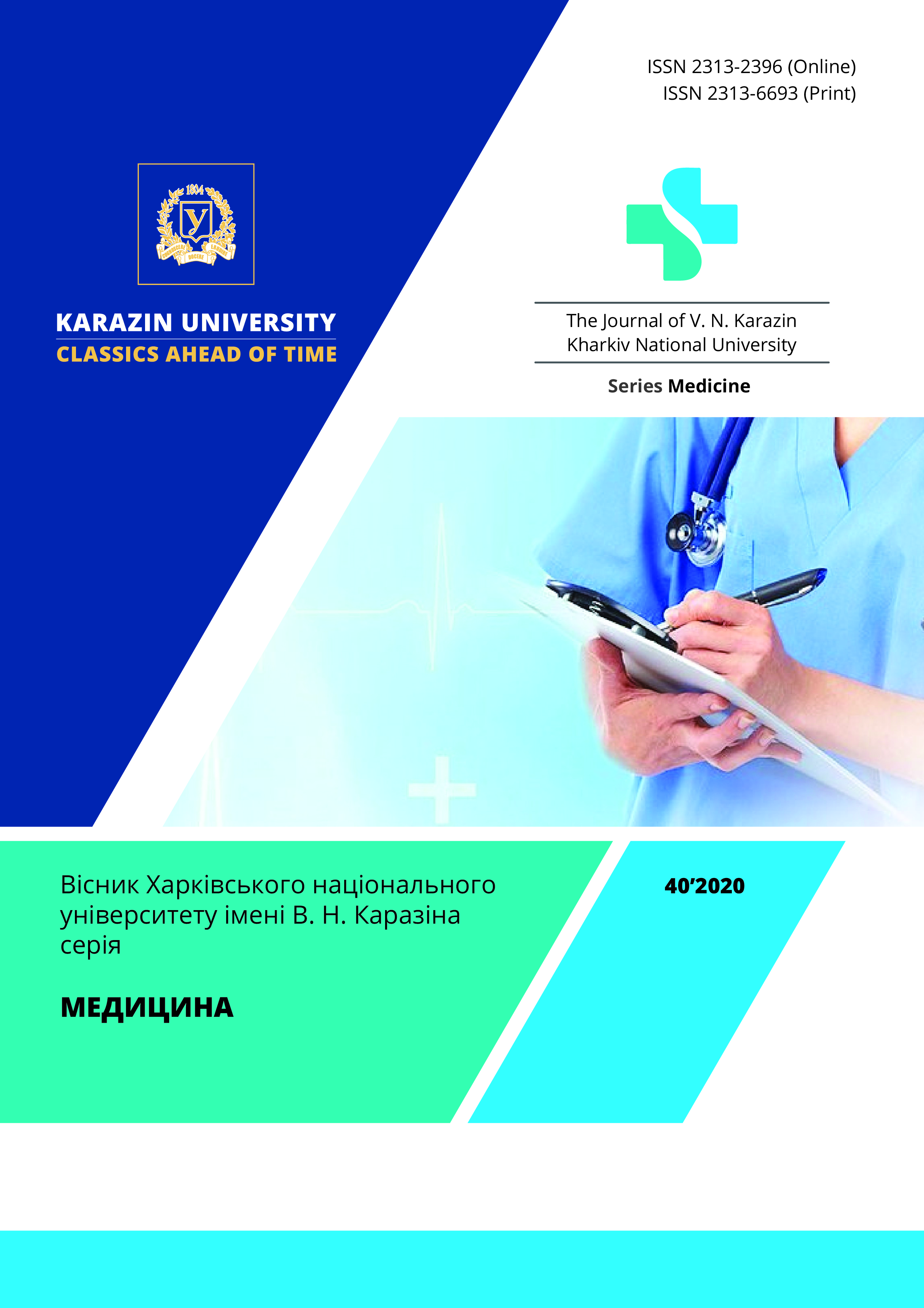Influence of drinking water quality on the population health in the hulyaipilskyi rural district
Abstract
Introduction. The data presented by us is characterize priority problems in the field of drinking water supply and quality of drinking water that are relevant for many regions of Ukraine, including for Hulyaipilskyi district of the Zaporizhzhskyi region, whose population receives drinking water with deviations in some indicators from hygienic standards. Objective - to study impact of mineral composition of drinking water on the health state population in five experimental districts (Vozdvyzhenskyi, Komsomolskyi, Novozlativskyi, Uspenivskyi and Malynovskyi) of Zaporizhzhskyi region in comparison with control Hulyaipilskyi district (with the lowest levels of diseases among population). Materials and methods. Study of drinking water quality from centralized and decentralized water supply sources in Hulyaipilskyi district (102 studies in total). Indicators of general and primary morbidity among adult population in Hulyaipilskyi district were studied for the last 5-year period (280 studies in total). Indicators of general and primary morbidity among adult population in the individual hospital districts were analyzed according to the medical records (350 studies totally). Results. Deterioration of the qualitative composition of drinking water with an increased level of total mineralization during 2015–2019 was established on the territory of individual rural areas: from 1.15 to 21.82 times. A reliably high level prevalence of kidney stones and diseases of the urinary system, diseases of the circulatory system, hypertension, coronary heart disease was shown in the territory of rural districts: Komsomolskyi, Novozlatopilskyi, Uspenskyi and Malinovskyi among adult population, compared with average annual indicator in the Hulyaipilskyi rural district (p < 0.001). Conclusions. There was a tendency to increase incidence of hypertension in all rural hospital areas during 2015–2019 years. Statistically significant correlation of average strength were revealed between individual components of the mineral composition of drinking water: hardness, dry residue, total mineralization and prevalence of III, XIV classes of diseases by ICD-10 (r = 0.30, p < 0.05).
Downloads
References
Wu L, Li X, Liu C, Zhao J, Mao Y, Sun Z, Zheng P. Equivalence test between trial method and reference method of the total coliforms and E. Coli in water. Wei Sheng Yan Jiu. 2017; 46 (5): 793–796.
Hale C, Scallan E, Cronquist A. Estimates of enteric illness attributable to contact with animals and their environments in the United States. Clin. Infect. 2012. [Electronic resource]. – Assess mode: https://academic.oup.com/cid/article-abstract/54/suppl_5/S472/432063
European Health for All databases HFA-DB. – Copenhagen: WHO Regional Office for Europe, 2010. – Access mode: http://www.euro.who.int/hfadb.
Penakalapati G, Swarthout J, Delahoy MJ. Exposure to animal feces and human health: A systematic review and proposed research priorities. Environmental science & technology. 2019; 51 (20): 37–42.
Adimalla N, Venkatayogi S. Geochemical characterization and evaluation of groundwater suitability for domestic and agricultural utility in semi-arid region of Basara, South India. 2018 Appl. Water Sci; 8:44–54.
Bain R, Cronk R, Hossain R, Bonjour S, Onda K, Wright J, et al. Global assessment of exposure to contamination through drinking water based on a systematic review. Trop Med [Electronic resource]. 2014. https://doi.org/10.1111/tmi.12334/full
Narsimha A, Sudarshan V, Srinivasulu P, Vishnu B, Ramana Kumar M, Kumar S. Niranjan. Groundwater quality and its suitability for drinking and agricultural purpose around Chityal Area, Nalgonda District, India. Water Res. Dev. 2012; 2 (3): 68–75.
Guidelines for drinking water quality / World Health Organization. – The 4d ed. Vol. 1. Recommendations. Geneva. 2011. 501 p.
Hryhorenko LV. Water quality assessment in the mining and industrial region on the example of Karachunovskyi reservoir in Ukraine. Advanced Engineering Forum. 2019; 33: 19–31.
Hryhorenko LV, Baibakov VM. Analysis of indicators of public health in the Kamensko-Dneprovskyi rural region. Medical perspectives. 2019; 4 (24): 160–176.
Berdnyk OV, Zaikovska VYu. The feasibility of using different health indicators in assessing environmental impact. Hihiiena naselenykh mists: zbirnyk naukovykh prats. 2008; 52: 417–422. [in Ukrainian]
Tymchenko OI, Kartashova SS, Lynchak OV. The genetic component as a factor in the formation of health Ukraine. Ekolohiia dovkillia ta bezpeka zhyttiediialnosti. 2005; 1: 3–8. [in Ukrainian]
Hryhorenko LV, Baibakov VM, Zayats IA, Solomenko MV, Romanenko OA. Dynamics of infectious and parasitogenic morbidity at the children population in the rural districts and correlation with water factor. Wiadomosci Lekarskie. 2019; 5 (2): 1029–1032.
Prokopov VO, Trush YeA, Kulish TV, Sobol VA. Toksychni khlororhanichni spoluky u khlorovanii pytnii vodi mist Dniprovskoho baseinu [Toxic organochlorine compounds in chlorinated drinking water in the cities of Dnieper basin]. Dovkillia ta zdorovia. 2016; 2 (78): 39–43. [in Ukrainian].
Prokopov V O, Chychkovska HV, Zorina OV. Khlororhanichni spoluky u pytnii vodi: faktory ta umovy yikh utvorennia [Organochlorine compounds in drinking water: factors and conditions of their formation]. Dovkillia ta zdorov`ia. 2004; 2 (29): 70–74. [in Ukrainian].
Prokopov VA, Shushkovskaja SV. Vlijanie hlorirovannoj pit'evoj vody na zabolevaemost' naselenija rakom obodochnoj kishki [Influence of chlorinated drinking water on the incidence of colon cancer in the population]. Dovkіllja ta zdorov’ja. 2012; 4: 46–51. [in Russian].
Chychkovska H V, Prokopov VO, Zorina OV. Tryhalometany u pytnii vodi ta anomalni naslidky pry ditonarodzhenni [Trihalomethanes in drinking water and abnormal effects in childbirth]. Dovkillia ta zdorov`ia. 2002; 3 (22): 24–28. [in Ukrainian].
Hryhorenko LV, Bashmakov DH. Health status of children population under influence of the chemical composition of drinking water. Wiadomosci Lekarskie. 2020; 4: 798–803.
The Journal of V. N. Karazin Kharkiv National University, series Medicine has following copyright terms:
- Authors retain copyright and grant the journal right of first publication with the work simultaneously licensed under a Creative Commons Attribution License that allows others to share the work with an acknowledgement of the work’s authorship and initial publication in this journal.
- Authors are able to enter into separate, additional contractual arrangements for the non-exclusive distribution of the journal’s published version of the work, with an acknowledgement of its initial publication in this journal.
- Authors are permitted and encouraged to post their work online prior to and during the submission process, as it can lead to productive exchanges, as well as earlier and greater citation of published work.




